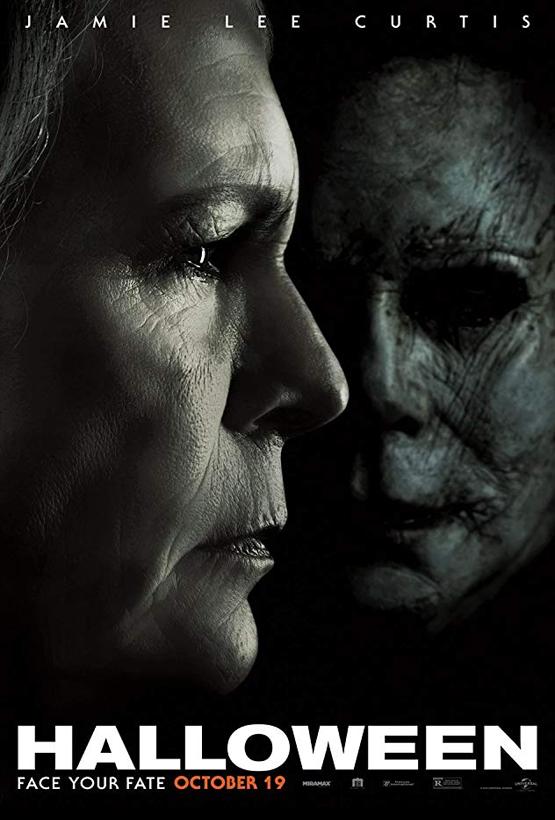On a Friday night during the opening weekend of John Carpenter’s 1978 slasher horror classic, my father sat in a mostly filled theater; now, 40 years later, he finds himself in the exact same situation for the 2018 sequel. My father and I settled into our chairs and on the screen was the title of the film in the exact same font and color as the original. We shot each other a quick glance, exchanging slight smiles before returning our eyes to the screen. We sat and watched, both of us hoping for the film to continue replicating the rest of the title sequence with as much perfection as the previous shot. And we got exactly what we wished for, pumpkin and all. Trailer courtesy of Universal Pictures YouTube page For the second remake of the film’s namesake, “Halloween” reunites Laurie Strode (Jamie Lee Curtis) with the man who has terrorized her for the last 40 years since that horrific night, Michael Myers. Like every other remake, 2018’s “Halloween” relies heavily on the source material with repeating set-pieces from the original. But unlike the Rob Zombie 2007 remake, which recreated sequences frame for frame condensed into half the time, this film incorporates the concept of remaking the events of the initial film directly into the plot. The film ignores all of the sequels in the franchise, including the concept that Laurie is actually Michael’s sister from “Halloween II.” Instead, now she is just a random victim who has dedicated her life, and the lives of her daughter Karen (Judy Greer) and granddaughter Allyson (Andi Matichak), to prepare for his inevitable escape. In almost identical circumstances as the original film, Michael Myers stalks the small Illinois town of Haddonfield after he escapes from a bus crash when he is being transferred to a new supermax prison from the mental institution he has been held in for the last 40 years. But this time, Michael isn’t the only one looking for prey. Laurie has waited for this moment and she won’t let this monster get away this time. While the film’s plot structure does keep the pace moving and the audience engaged, there are a few incidents where characters make decisions just to get other characters to the next location and to ultimately satisfy set-pieces. The film is directed and co-written by David Gordon Green along with Danny McBride. Green and McBride have worked together on several projects including “Pineapple Express”, “Eastbound and Down” and “Vice Principals.” For the most part, the comedy duo successfully creates a suspenseful atmosphere and graphic murders that could hold its own with more modern horror films as well as John Carpenter’s classic. There are some sequences in the film where Green and McBride’s roots shine through. The tense threat of the emotionless killer becomes forgotten and a humorous aside interrupts the flow of the film. Besides those occasional moments, the film feels like a legitimate sequel to Carpenter’s far more than other films in the franchise like “Halloween 4: The Return of Michael Myers” or “Halloween H20: 20 Years Later.” One element of the film that achieves that connectivity with the original is the return of Carpenter for the score of the film along with the use of the same font and opening credit sequence. Both match the tone and feel of the original and lets the audience settle into the film with confidence that Carpenter gave his blessing for the film, something that is not always true for remakes of Carpenter’s work, like the 2011 version of “The Thing.”
Spoilers Below
During the film, there were two moments that caused some discussion between my father and I that shows the difference in our reactions. The first was with the comedic moments described earlier. For my father, those segments killed all momentum and he especially found the last set of jokes in the third act so jarring that he said it took him at least 5 to 7 minutes before he became re-engrossed in the film. The other point of debate was in the murder of two teens and how the difference between our generations informed how the rules of a horror film should work. As many fans of horror films are aware, there are rules within these films that usually signals to the audience which characters are in the film to rack up the body count and which are intended to be main characters whose deaths are mourned. Traditionally, two types of characters, which are featured in the 2018 film, are automatically pushed into the chopping block category: stoners and sexually active teenagers. That trope can be seen in other horror films like “Friday the 13th” as well as in the 1978 “Halloween.” The 2018 version recreates that scene from the original, almost repeating the deaths of the two high schoolers perfectly with the exception of Michael’s sister’s tombstone. But the main difference between those two sequences is how those deaths are treated. In the original, Carpenter gives those characters callous, hedonistic personas that signal the audience not get too attached to the couple and we watch both murders in their entirety. Green appears to treat the couple with respect, having both of the babysitter and the boyfriend acting heroically with the babysitter telling the kid to escape when she is literally in Michael’s clutches and the boyfriend choosing to go into house even though he is clearly frightened. Even their deaths show the respect the film has for these characters. Their murders occur off screen after a string of several murders of random people just minutes before and it is the first set of deaths that the police react too showing the audience how the should react, mournful. After the screening, I expressed my surprise about Green’s perspective and how society has changed its typical view of people who smoke marijuana or have premarital sex. Where those same people would have been cannon fodder for the killer, now they are seen as someone who should be mourned or whose death should be impactful. My father did not share my reaction. Through his eyes, he thought that the film treated that couple just as they would have 40 years ago. From the moment that the babysitter said her boyfriend was coming over, he knew they weren’t making it to the end credits. Another instance where our generational difference changed how we each perceived a kill was in the death of Allyson’s friend, Oscar. After Allyson’s boyfriend, Cameron, kisses another girl at the high school dance, Allyson and Oscar leave the party and have a conversation where Oscar says that Allyson is the smartest, prettiest girl in school. Allyson appreciates the compliment and Oscar interprets that as a sign of interest. Oscar then leads Allyson through a “shortcut,” where after they climb a spiked iron fence he tries to kiss her even though she says no and rejects him. From my perspective, I would describe Oscar’s actions as the start of a sexual assault. In that scene, he lies to Allyson to get her secluded and trapped before making his move. Regardless of the new set of rules for what establishes who can be murdered, Oscar’s actions clearly put him in Michael’s crosshairs. That logic follows into my father’s assessment of the scene. For him, Oscar fell into just another one of the archetypal slasher characters: the nerd.
Verdict 7.5/10
“Halloween” 2018 is one of the better, if not best, sequels in the franchise, but never achieves the heights of the original. Fans of the original should expect some additional enjoyment picking out all of the replicated shots that adds another layer to entertain oneself when you know what is going to happen next. The visuals constantly remind the audience of the original, but never feels like an imitation. While there are occasions where the creators’ comedy background does break up the tension, overall the film is successful in keeping up the tension. There are plenty of creative kills that I would expect in a slasher film and as a successor Carpenter’s masterpiece.







